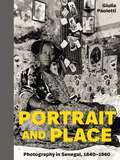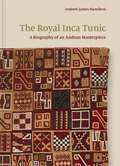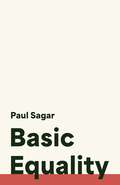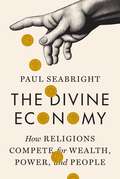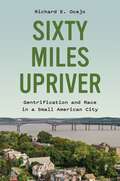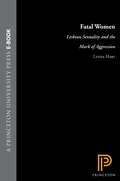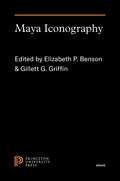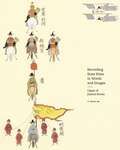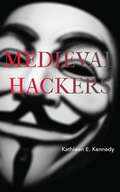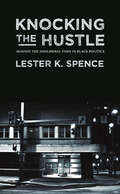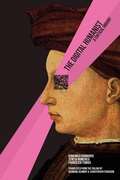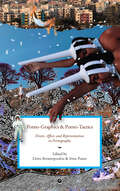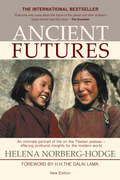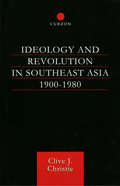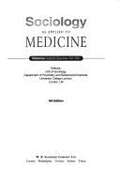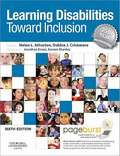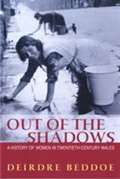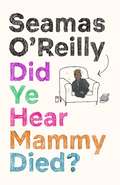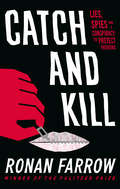- Table View
- List View
Portrait and Place: Photography in Senegal, 1840–1960
by Giulia PaolettiA richly illustrated history of photography in one of the epicenters of African modernityWhen the daguerreotype first arrived in sub-Saharan Africa in the early nineteenth century, local kingdoms still held power in Senegal and the French presence was limited to trading outposts along the coast. The pioneers of photography in Senegal worked within, across, and beyond the borders of colonial empire, expanding the medium&’s possibilities and contributing to a global visual language. Portrait and Place explores these unique encounters, providing an in-depth and nuanced look at the images made at the intersection of Black Atlantic, Islamic, and African cultures.Giulia Paoletti takes readers on a visual journey from the 1840s, when the oldest-surviving daguerreotype from West Africa was made, to the 1960s, when photography became the most popular medium as Senegal achieved its independence. She discusses some of Africa&’s most celebrated modernists, such as Mama Casset, and also offers insights into lesser-known photographers like Oumar Ka and once-anonymous figures such as Macky Kane. Paoletti examines both professional and amateur artists in genres ranging from portraiture to landscape and across media such as glass painting and lithography.Featuring a wealth of breathtaking images published here for the first time, Portrait and Place brings to life the important histories of photography on the African continent.
The Royal Inca Tunic: A Biography of an Andean Masterpiece
by Andrew James HamiltonThe hidden life of the greatest surviving work of Inca artThe most celebrated Andean artwork in the world is a five-hundred-year-old Inca tunic made famous through theories about the meanings of its intricate designs, including attempts to read them as a long-lost writing system. But very little is really known about it. The Royal Inca Tunic reconstructs the history of this enigmatic object, presenting significant new findings about its manufacture and symbolism in Inca visual culture.Andrew James Hamilton draws on meticulous physical examinations of the garment conducted over a decade, wide-ranging studies of colonial Peruvian manuscripts, and groundbreaking research into the tunic&’s provenance. He methodically builds a case for the textile having been woven by two women who belonged to the very highest echelon of Inca artists for the last emperor of the Inca Empire on the eve of the Spanish invasion in 1532. Hamilton reveals for the first time that this imperial vestment remains unfinished and has suffered massive dye fading that transforms its appearance today, and he proposes a bold new conception of what this radiant masterpiece originally looked like.Featuring stunning photography of the tunic and Hamilton&’s own beautiful illustrations, The Royal Inca Tunic demonstrates why this object holds an important place in the canon of art history as a deft creation by Indigenous women artists, a reminder of the horrors of colonialism, and an emblem of contemporary Andean identity.
The Royal Inca Tunic: A Biography of an Andean Masterpiece
by Andrew James HamiltonThe hidden life of the greatest surviving work of Inca artThe most celebrated Andean artwork in the world is a five-hundred-year-old Inca tunic made famous through theories about the meanings of its intricate designs, including attempts to read them as a long-lost writing system. But very little is really known about it. The Royal Inca Tunic reconstructs the history of this enigmatic object, presenting significant new findings about its manufacture and symbolism in Inca visual culture.Andrew James Hamilton draws on meticulous physical examinations of the garment conducted over a decade, wide-ranging studies of colonial Peruvian manuscripts, and groundbreaking research into the tunic&’s provenance. He methodically builds a case for the textile having been woven by two women who belonged to the very highest echelon of Inca artists for the last emperor of the Inca Empire on the eve of the Spanish invasion in 1532. Hamilton reveals for the first time that this imperial vestment remains unfinished and has suffered massive dye fading that transforms its appearance today, and he proposes a bold new conception of what this radiant masterpiece originally looked like.Featuring stunning photography of the tunic and Hamilton&’s own beautiful illustrations, The Royal Inca Tunic demonstrates why this object holds an important place in the canon of art history as a deft creation by Indigenous women artists, a reminder of the horrors of colonialism, and an emblem of contemporary Andean identity.
Basic Equality
by Paul SagarAn innovative argument that vindicates our normative commitment to basic equality, synthesising philosophy, history, and psychologyWhat makes human beings one another&’s equals? That we are "basic equals" has become a bedrock assumption in Western moral and political philosophy. And yet establishing why we ought to believe this claim has proved fiendishly difficult, floundering in the face of the many inequalities that characterise the human condition. In this provocative work, Paul Sagar offers a novel approach to explaining and justifying basic equality. Rather than attempting to find an independent foundation for basic equality, he argues, we should instead come to see our commitment to this idea as the result of the practice of treating others as equals. Moreover, he continues, it is not enough to grapple with the problem through philosophy alone—by just thinking very hard, in our armchairs; we must draw insights from history and psychology as well.Sagar writes that, as things stand, there appear to be no good arguments for believing in the truth of basic equality. Indeed, for much of Western intellectual history and social practice, basic inequality has been the default position. How is it then, Sagar asks, that in Western societies, in a period of less than a century, basic equality emerged as the dominant view? Sagar approaches this not as a mere philosophical puzzle, but as a dramatic historical development. In so doing, he shows us what is at stake when human beings treat one another as equals just because they are human beings.
The Divine Economy: How Religions Compete for Wealth, Power, and People
by Paul SeabrightA novel economic interpretation of how religions have become so powerful in the modern worldReligion in the twenty-first century is alive and well across the world, despite its apparent decline in North America and parts of Europe. Vigorous competition between and within religious movements has led to their accumulating great power and wealth. Religions in many traditions have honed their competitive strategies over thousands of years. Today, they are big business; like businesses, they must recruit, raise funds, disburse budgets, manage facilities, organize transportation, motivate employees, and get their message out. In The Divine Economy, economist Paul Seabright argues that religious movements are a special kind of business: they are platforms, bringing together communities of members who seek many different things from one another—spiritual fulfilment, friendship and marriage networks, even business opportunities. Their function as platforms, he contends, is what has allowed religions to consolidate and wield power.This power can be used for good, especially when religious movements provide their members with insurance against the shocks of modern life, and a sense of worth in their communities. It can also be used for harm: political leaders often instrumentalize religious movements for authoritarian ends, and religious leaders can exploit the trust of members to inflict sexual, emotional, financial or physical abuse, or to provoke violence against outsiders. Writing in a nonpartisan spirit, Seabright uses insights from economics to show how religion and secular society can work together in a world where some people feel no need for religion, but many continue to respond with enthusiasm to its call.
Sixty Miles Upriver: Gentrification and Race in a Small American City
by Richard E. OcejoAn unvarnished portrait of gentrification in an underprivileged, majority-minority small cityNewburgh is a small postindustrial city of some twenty-eight thousand people located sixty miles north of New York City in the Hudson River Valley. Like many other similarly sized cities across America, it has been beset with poverty and crime after decades of decline, with few opportunities for its predominantly minority residents. Sixty Miles Upriver tells the story of how Newburgh started gentrifying, describing what happens when White creative professionals seek out racially diverse and working-class communities and revealing how gentrification is increasingly happening outside large city centers in places where it unfolds in new ways.As New York City&’s housing market becomes too expensive for even the middle class, many urbanites are bypassing the suburbs and moving to smaller cities like Newburgh, where housing is affordable and historic. Richard Ocejo takes readers into the lives of these newcomers, examining the different ways they navigate racial difference and inequality among Newburgh&’s much less privileged local residents, and showing how stakeholders in the city&’s revitalization reframe themselves and gentrification to cast the displacement they cause to minority groups in a positive light.An intimate exploration of the moral dilemma at the heart of gentrification, Sixty Miles Upriver explains how progressive White gentrifiers justify controversial urban changes as morally good, and how their actions carry profound and lasting consequences for vulnerable residents of color.
Sixty Miles Upriver: Gentrification and Race in a Small American City
by Richard E. OcejoAn unvarnished portrait of gentrification in an underprivileged, majority-minority small cityNewburgh is a small postindustrial city of some twenty-eight thousand people located sixty miles north of New York City in the Hudson River Valley. Like many other similarly sized cities across America, it has been beset with poverty and crime after decades of decline, with few opportunities for its predominantly minority residents. Sixty Miles Upriver tells the story of how Newburgh started gentrifying, describing what happens when White creative professionals seek out racially diverse and working-class communities and revealing how gentrification is increasingly happening outside large city centers in places where it unfolds in new ways.As New York City&’s housing market becomes too expensive for even the middle class, many urbanites are bypassing the suburbs and moving to smaller cities like Newburgh, where housing is affordable and historic. Richard Ocejo takes readers into the lives of these newcomers, examining the different ways they navigate racial difference and inequality among Newburgh&’s much less privileged local residents, and showing how stakeholders in the city&’s revitalization reframe themselves and gentrification to cast the displacement they cause to minority groups in a positive light.An intimate exploration of the moral dilemma at the heart of gentrification, Sixty Miles Upriver explains how progressive White gentrifiers justify controversial urban changes as morally good, and how their actions carry profound and lasting consequences for vulnerable residents of color.
Fatal Women: Lesbian Sexuality and the Mark of Aggression
by Lynda HartA groundbreaking and provocative look at how violent women have been represented in literature, plays, film, and performanceFatal Women builds a complex and original theory of how the shadow of the lesbian animates representations of violent women, from the Victorian novel to films depicting women who kill. Starting from the historical link between criminality and sexual deviancy, Lynda Hart critiques constructions of gender, race, class, sexualities, and the cultural politics of the 1990s. Her introductory chapter constructs a theory of female violence across the discourses of sexology, criminology, and psychoanalysis. Subsequent chapters detail this theory in the Victorian novel and stage sensation Lady Audley&’s Secret; Frank Wedekind&’s Lulu Plays, which introduced the &“invert&” to the European stage; the films Thelma and Louise, Mortal Thoughts, and Basic Instinct; the political intersection of race and gender in Single White Female; the performance art of Karen Finley in the context of the censorship debates; the fate of Aileen Wuornos, dubbed the first &“female serial killer&” by the FBI; and the Split Britches&’ performance Lesbians Who Kill.A major contribution to lesbian theory and cultural studies, Fatal Women is certain to be read widely by scholars, students, and anyone interested in the politics of representation.
Maya Iconography
by Elizabeth P. Benson Gillett G. GriffinA landmark work on the iconography of one of the world&’s great civilizationsThis book presents foundational work on Maya iconography from leading practitioners in fields ranging from archaeology, anthropology, and art history to linguistics, astronomy, photography, and medicine. The period discussed runs from the last centuries B.C. through the great Maya Classic period, with some discussion of later eras and of regions outside the Maya area. Featuring an incisive introduction by Elizabeth Benson and Gillett Griffin, Maya Iconography demonstrates how Maya beliefs developed over time and makes important connections between Preclassic and Classic iconography.The contributors are John Carlson, Michael Coe, David Freidel, Donald Hales, Norman Hammond, Nicholas Hellmuth, John Justeson, Barbara Kerr, Justin Kerr, Mary Ellen Miller, William Norman, Lee Parsons, Francis Robicsek, Linda Schele, David Stuart, and Karl Taube.
Maya Iconography
by Elizabeth P. Benson Gillett G. GriffinA landmark work on the iconography of one of the world&’s great civilizationsThis book presents foundational work on Maya iconography from leading practitioners in fields ranging from archaeology, anthropology, and art history to linguistics, astronomy, photography, and medicine. The period discussed runs from the last centuries B.C. through the great Maya Classic period, with some discussion of later eras and of regions outside the Maya area. Featuring an incisive introduction by Elizabeth Benson and Gillett Griffin, Maya Iconography demonstrates how Maya beliefs developed over time and makes important connections between Preclassic and Classic iconography.The contributors are John Carlson, Michael Coe, David Freidel, Donald Hales, Norman Hammond, Nicholas Hellmuth, John Justeson, Barbara Kerr, Justin Kerr, Mary Ellen Miller, William Norman, Lee Parsons, Francis Robicsek, Linda Schele, David Stuart, and Karl Taube.
Recording State Rites in Words and Images: Uigwe of Joseon Korea (Publications Of The Tang Center For East Asian Art, Princeton University Ser. #16)
by Yi Song-miA beautifully illustrated, interdisciplinary look at the ceremonies and protocols of the dynastic court of Joseon KoreaRecording State Rites in Words and Images provides an engaging and in-depth exploration of the large corpus of court statutes compiled during the Joseon dynasty of Korea. The term uigwe, commonly translated as &“royal protocols,&” is the name given to the collection of nearly four thousand books that were commissioned and written to document the customs, rituals, rules, protocols, and ceremonial practices of the Joseon dynasty. In this generously illustrated book, Yi Song-mi introduces readers to the rich and varied documentary tradition embodied in the uigwe, sharing invaluable insights into time-honored court customs through text and images and analyzing changes in ritual practice over time.The first comprehensive study of its kind in English, Recording State Rites in Words and Images presents groundbreaking research that opens a window on Korean history and art and will serve as an inspiration to students, scholars, and anyone interested in topics such as dynastic customs, court artists, and bookmaking.Published in association with the P. Y. and Kinmay W. Tang Center for East Asian Art at Princeton University
Medieval Hackers
by Kathleen E. KennedyMedieval Hackers calls attention to the use of certain vocabulary terms in the Middle Ages and today: commonness, openness, and freedom. Today we associate this language with computer hackers, some of whom believe that information, from literature to the code that makes up computer programs, should be much more accessible to the general public than it is. In the medieval past these same terms were used by translators of censored texts, including the bible. Only at times in history when texts of enormous cultural importance were kept out of circulation, including our own time, does this vocabulary emerge. Using sources from Anonymous’s Fawkes mask to William Tyndale’s Bible prefaces, Medieval Hackers demonstrates why we should watch for this language when it turns up in our media today. This is important work in media archaeology, for as Kennedy writes in this book, the “effluorescence of intellectual piracy” in our current moment of political and technological revolutions “cannot help but draw us to look back and see that the enforcement of intellectual property in the face of traditional information culture has occurred before….We have seen that despite the radically different stakes involved, in the late Middle Ages, law texts traced the same trajectory as religious texts. In the end, perhaps religious texts serve as cultural bellwethers for the health of the information commons in all areas. As unlikely as it might seem, we might consider seriously the import of an animatronic [John] Wyclif, gesturing us to follow him on a (potentially doomed) quest to preserve the information commons.
Knocking the Hustle: Against the Neoliberal Turn in Black Politics
by Lester K. SpenceOver the past several years scholars, activists, and analysts have begun to examine the growing divide between the wealthy and the rest of us, suggesting that the divide can be traced to the neoliberal turn. “I’m not a business man; I’m a business, man.” Perhaps no better statement gets at the heart of this turn. Increasingly we’re being forced to think of ourselves in entrepreneurial terms, forced to take more and more responsibility for developing our “human capital.” Furthermore a range of institutions from churches to schools to entire cities have been remade, restructured to in order to perform like businesses. Finally, even political concepts like freedom, and democracy have been significantly altered. As a result we face higher levels of inequality than any other time over the last century. In Knocking the Hustle: Against the Neoliberal Turn in Black Politics, Lester K. Spence writes the first book length effort to chart the effects of this transformation on African American communities, in an attempt to revitalize the black political imagination. Rather than asking black men and women to “hustle harder” Spence criticizes the act of hustling itself as a tactic used to demobilize and disempower the communities most in need of empowerment.
The Digital Humanist: A Critical Inquiry
by Domenico Fiormonte Teresa Numerico Francesca TomasiThis book offers a critical introduction to the core technologies underlying the Internet from a humanistic perspective. It provides a cultural critique of computing technologies, by exploring the history of computing and examining issues related to writing, representing, archiving and searching. The book raises awareness of, and calls for, the digital humanities to address the challenges posed by the linguistic and cultural divides in computing, the clash between communication and control, and the biases inherent in networked technologies. A common problem with publications in the Digital Humanities is the dominance of the Anglo-American perspective. While seeking to take a broader view, the book attempts to show how cultural bias can become an obstacle to innovation both in the methodology and practice of the Digital Humanities. Its central point is that no technological instrument is culturally unbiased, and that all too often the geography that underlies technology coincides with the social and economic interests of its producers. The alternative proposed in the book is one of a world in which variation, contamination and decentralization are essential instruments for the production and transmission of digital knowledge. It is thus necessary not only to have spaces where DH scholars can interact (such as international conferences, THATCamps, forums and mailing lists), but also a genuine sharing of technological know-how and experience.
Porno-Graphics and Porno-Tactics: Desire, Affect, and Representation in Pornography
by Eirini Avramopoulou Irene PeanoPorno-Graphics and Porno-Tactics asks whether, and how, it is possible to re-appropriate pornography and think through it critically and creatively for a project of liberation. In the different contributions which make up this deliberately heterogeneous collection of short, non-canonical essays, such a quest proceeds by re-articulating the aporias of desire, intimacy, touch and seduction. It also relates them to claims of visibility, visions of emancipation and its failures, as well as to the politics of violence that we get exposed to through circulating images and affects. This is an attempt to exceed the limits set by and for ourselves in relation to how we connect to our own bodies, to the bodies of our lovers and to the bodies of the theories we live with, sleep with and dream about – in short, to all that we get attached to. The editors and contributors of this collection do not claim the euphoric potentiality of pornography as necessarily subversive and emancipatory, but are nevertheless open to the possibilities of re-shaping it (in textual, contextual, intertextual, but also affective and embodied forms) through different graphic and tactical/tactile inscriptions. On the one hand, authors reflect on definitions and practices of pornography as a genre adopting specific codes and canons, whether it is concerned with sex acts and the industry of porn or with other predominant forms of representation and the structures of power underlying them. On the other hand, chapters relate to the more affective, libidinal, synaesthetic and inter/subjective dimensions of pornography, and on the capacity of different reappropriations to subvert its limits.
Ancient Futures: Lessons From Ladakh For A Globalizing World (3rd edition)
by Helena Norberg-Hodge H.H. The Dalai LamaA moving portrait of tradition and change in Ladakh, or “Little Tibet,” Ancient Futures is also a scathing critique of the global economy and a rallying call for economic localization. When Helena Norberg-Hodge first visited Ladakh in 1975, she found a pristine environment, a self-reliant economy and a people who exhibited a remarkable joie de vivre. But then came a tidal wave of economic growth and development. Over the last four decades, this remote Himalayan land has been transformed by outside markets and Western notions of “progress.” As a direct result, a whole range of problems—from polluted air and water to unemployment, religious conflict, eating disorders and youth suicide—have appeared for the first time. Yet this is far from a story of despair. Social and environmental breakdown, Norberg-Hodge argues, are neither inevitable nor evolutionary, but the products of political and economic decisions—and those decisions can be changed. In a new Preface, she presents a kaleidoscope of projects around the world that are pointing the way for both human and ecological well-being. These initiatives are the manifestation of a rapidly growing localization movement, which works to rebuild place-based cultures—strengthening community and our connection with nature. Ancient Futures challenges us to redefine what a healthy economy means, and to find ways to carry centuries-old wisdom into our future. The book and a related film by the same title have, between them, been translated into more than 40 languages.
Ideology and Revolution in Southeast Asia 1900-1980: Political Ideas of the Anti-Colonial Era
by Clive J. ChristieThe concept of 'Asian Values' has recently been emphasized by East and South East Asian political leaders. These leaders have argued that European political values have exercised an unhealthy hegemony over the international system, not only because of global influence exercised by European ideas during the colonial period, but because of 'Anglo-Saxon' dominance over the world orders that were set up in the aftermath of both the First and Second World Wars. This book considers the interaction between indigenous ('Asian') values and European ideology and the influence this relationship had on the nationalist and revolutionary movements of Southeast Asia that dominated the political systems of Southeast Asia in the period 1945-1975.
Ideology and Revolution in Southeast Asia 1900-1980: Political Ideas of the Anti-Colonial Era (PDF)
by Clive J. ChristieThe concept of 'Asian Values' has recently been emphasized by East and South East Asian political leaders. These leaders have argued that European political values have exercised an unhealthy hegemony over the international system, not only because of global influence exercised by European ideas during the colonial period, but because of 'Anglo-Saxon' dominance over the world orders that were set up in the aftermath of both the First and Second World Wars. This book considers the interaction between indigenous ('Asian') values and European ideology and the influence this relationship had on the nationalist and revolutionary movements of Southeast Asia that dominated the political systems of Southeast Asia in the period 1945-1975.
Sociology As Applied To Medicine (PDF)
by Graham ScamblerThe 4th edition of this firmly established text gives a comprehensive introduction to the sociology of health, illness and health policy. Presents the principles of medical sociology and emphasizes practical issues. The text is concise, and designed in two colors with highlight boxes for easy use.
Learning Disabilities: Toward Inclusion (Sixth Edition) (PDF)
by Helen Atherton Debbie CrickmoreLearning Disabilities: Toward Inclusion (formerly edited by Bob Gates) is one of the leading textbooks in this field. It offers real ways to improve quality of experience for people with learning disabilities in all areas of life. This new edition brings together a comprehensive and coherent collection of material from eminent authors with a wealth of professional backgrounds and roles. Its contemporary focus reflects practice developments including the impact of changing policy and legislation on the nature and configuration of services.
Psychology And Sociology Applied To Medicine: An Illustrated Colour Text (PDF)
by Edwin Van Teijlingen Gerald M. HumphrisNow in its fourth edition, this definitive and popular introduction to human behaviour in the context of health and illness includes three new chapters, many new contributors and a new co-editor. It is arranged in nine sections to cover the core concepts of psychology and sociology as they apply to medicine.
Out Of The Shadows
by Deirdre BeddoeThis work reveals the story of women's lives in Wales during the 20th century. The areas of women's lives explored include: education; health; home life; leisure; politics; and waged work. The regional variations and differing linguistic and cultural traditions are also investigated.
Did Ye Hear Mammy Died?
by Seamas O'Reilly'A gorgeous memoir' Pandora Sykes'Tender, sad and side-splittingly funny' Annie MacManus'A heartfelt tribute to an alarmingly large family held together by a quietly heroic father' Arthur Mathews, co-creator of Father Ted and Toast of LondonSéamas O'Reilly's mother died when he was five, leaving him, his ten brothers and sisters and their beloved father in their sprawling bungalow in rural Derry. It was the 1990s; the Troubles were a background rumble (most of the time), and Séamas at that point was more preoccupied with dinosaurs, Star Wars and the actual location of heaven than the political climate.Did Ye Hear Mammy Died? is a book about a family of argumentative, loud, musical, sarcastic, grief-stricken siblings, shepherded into adulthood by a man whose foibles and reticence were matched only by his love for his children and his determination that they would flourish. It is the moving, often amusing and completely unsentimental story of a boy growing up in a family bonded by love, loss and fairly relentless mockery.'Not only hilarious, tender, absurd, delightful and charming, but written with such skill as to render it unforgettable' Nina Stibbe, author of Reasons to be Cheerful 'Grotesquely funny' Sophie Heawood, author of The Hungover Games
Catch and Kill: Lies, Spies and a Conspiracy to Protect Predators
by Ronan FarrowIn a dramatic account of violence and espionage, Pulitzer Prize-winning investigative reporter Ronan Farrow exposes serial abusers and a cabal of powerful interests hell-bent on covering up the truth, at any cost.In 2017, a routine network television investigation led Ronan Farrow to a story only whispered about: one of Hollywood's most powerful producers was a predator, protected by fear, wealth, and a conspiracy of silence. As Farrow drew closer to the truth, shadowy operatives, from high-priced lawyers to elite war-hardened spies, mounted a secret campaign of intimidation, threatening his career, following his every move and weaponizing an account of abuse in his own family. All the while, Farrow and his producer faced a degree of resistance that could not be explained - until now. And a trail of clues revealed corruption and cover-ups from Hollywood, to Washington, and beyond. This is the untold story of the exotic tactics of surveillance and intimidation deployed by wealthy and connected men to threaten journalists, evade accountability and silence victims of abuse - and it's the story of the women who risked everything to expose the truth and spark a global movement.Both a spy thriller and a meticulous work of investigative journalism, Catch and Kill breaks devastating new stories about the rampant abuse of power - and sheds far-reaching light on investigations that shook the culture.
